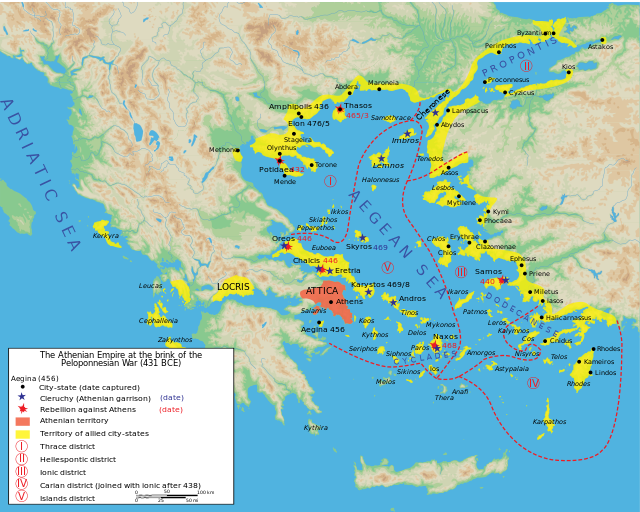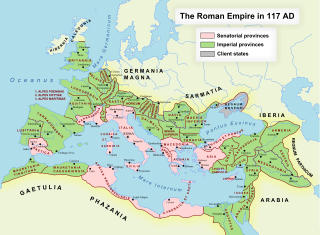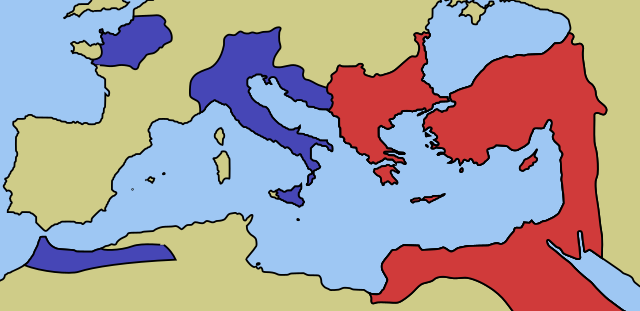Classical antiquity
age of the ancient Greeks and Romans From Wikipedia, the free encyclopedia
Remove ads
Classical antiquity (also the classical era or classical period) is a broad term for a long period of cultural history around the Mediterranean. It includes the civilizations of Ancient Greece and Ancient Rome, also known as the Greco-Roman world or Western world. Classical antiquity is the period in which Ancient Greek and Roman literature, such as those of Aeschylus and Ovid, flourished.[1] By convention, the period starts with the works of Homer in the 8th–7th century BC and ends with the arrival of Christianity and decline of the Western Roman Empire in the 5th and 6th centuries AD.[source?]
This page or section needs to be cleaned up. (December 2024) |
Remove ads
Archaic period: 8th to 6th centuries BC
The earliest period of classical antiquity took place before the reappearance of historical sources after the Bronze Age collapse. The earliest Greek alphabetic inscriptions are in the first half of the 8th century. Homer is usually assumed to have lived in the 8th or 7th century, and his lifetime is often taken as marking the beginning of classical antiquity. The traditional date for the first Ancient Olympic Games, in 776 BC, was also around this time. In Roman legend, the city of Rome was founded in 753 BC. The earliest settlement at the Roman Forum seems to have taken place around this time.[source?]
Phoenicians
The Phoenicians originally expanded from Levantine ports and by the 8th century were dominating trade in the Mediterranean. Carthage was founded in 814 BC, and the Carthaginians by 700 BC had firmly established strongholds in Sicily, Italy, and Sardinia, which brought about conflicts of interest with Etruria.[source?]
Greece
The Archaic period followed the Greek Dark Ages and saw the rise of democracy, philosophy, theatre, and poetry, as well as the revitalisation of the written language, which had been lost during the Dark Ages.[clarification needed]
Pottery styles of the later part of the Archaic Age are the black-figure pottery,[clarification needed] started in Corinth during the 7th century BC. Its successor was the red-figure style, developed by the Andokides in about 530 BC.[source?]
Remove ads
Classical Greece: 5th to 4th centuries BC



The classical period of Ancient Greece was from the fall of the Athenian tyranny in 510 BC to the death of Alexander the Great in 323 BC. During this period came the long struggle between Sparta and Athens and the wars between the Greeks and the Persians. The rise of Macedon in the 4th century overturned all other political systems, at least for a while.[source?]
Remove ads
Hellenistic period: 330 to 146 BC
The Hellenistic period began with Alexander the Great, whose conquest made Greek beoame the lingua franca far beyond Greece itself. Hellenistic culture came in contact with the cultures of Persia, Central Asia, India and Egypt. The Hellenistic period ended with the rise of the Roman Republic to a superregional power in the 2nd century BC and the Roman conquest of Greece in 146 BC.[source?]
Roman Republic: 5th to 1st centuries BC
The Roman Forum was the central area from which Ancient Rome developed.
The republican period of Ancient Rome began with the overthrow of the monarchy arund 509 BC and lasted over 450 years until its subversion through a series of civil wars that led to the Imperial period.[source?]
Roman Empire: 1st century BC to 5th century AD
Determining the precise end of the Republic is a matter of dispute.[2] Roman citizens of the time did not recognize that the Republic had ceased to exist. It could be said that Rome was already of imperial character. It had no emperor when it conquered what became the Roman provinces of Gaul, Illyria, Greece Hispania, and Asia.[source?]
Late antiquity (4th to 6th centuries AD)

During late antiquity, Christianity rose under Constantine the Great and finally became the official Roman religion in 393. Successive invasions of Germanic tribes meant the end of the Western Empire in the 5th century, but the Eastern Roman Empire persisted throughout the Middle Ages and later became known as the Byzantine Empire.[source?]
Revivalism
Respect for the ancients of Greece and Rome affected politics, philosophy, sculpture, literature, theater, education, architecture and sexuality. In politics, the presence of a Roman Emperor was felt to be desirable long after the empire fell. That tendency reached its peak when Charlemagne was crowned as Roman Emperor 800, an act that led to the formation of the Holy Roman Empire. The notion that an emperor is a monarch who outranks a mere king dates from that period. In that political ideal, there would always be a Roman Empire, a state whose jurisdiction would extend to the entire civilized Western world.[source?]
Remove ads
Related pages
Related pages
- Kofun period (Japan, 250 CE – 538 CE)
- Asuka period (Japan, 538 CE – 710 CE)
Notes
References
Wikiwand - on
Seamless Wikipedia browsing. On steroids.
Remove ads